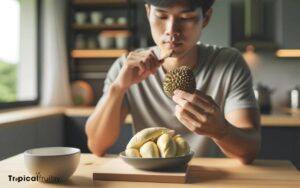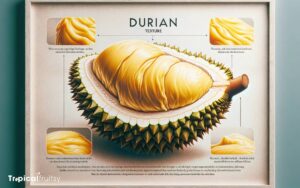How to Make Durian Custard? 6 Easy Steps!
To make durian custard, blend ripe durian flesh with sugar, milk, and eggs, then heat the mixture gently until it thickens. Serve chilled for a creamy tropical dessert.
Durian custard is a unique dessert recipe that combines the pungent, yet sweet flavor of durian fruit with the richness of a traditional custard.
Making this dessert involves a few essential steps:
An example of a basic recipe would include 200 grams of durian flesh, 100 grams of sugar, 250 milliliters of milk, and 3 eggs.
Delight in the exotic flavors of Southeast Asia with homemade durian custard, a dessert that perfectly marries the king of fruits with creamy, sweet indulgence.
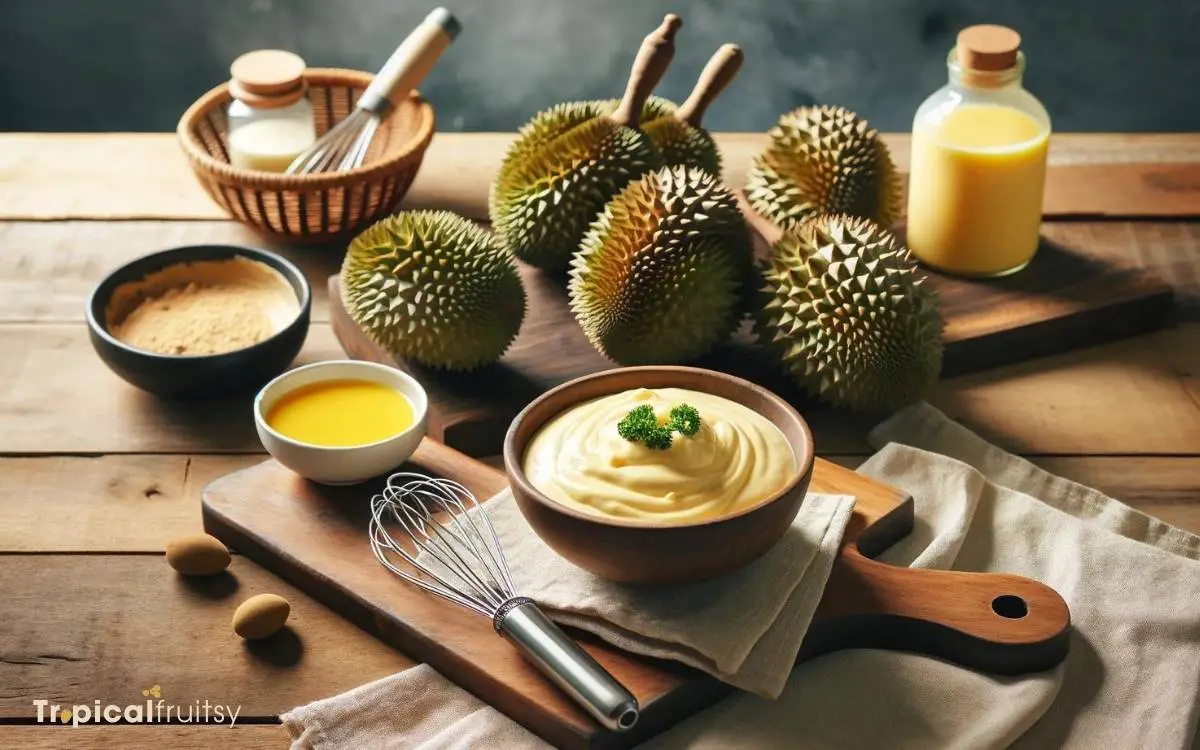
Key Takeaway
Step 1: Selecting the Perfect Durian

While choosing a durian for your custard, it is crucial to identify a fruit with a firm stem and a strong, aromatic scent, as these are indicators of ripeness and flavor intensity.
The husk should yield slightly under gentle pressure, revealing a subtle give that denotes a creamy, luscious interior.
Seek out durians with a rich, golden hue, avoiding those with any visible bruises or signs of premature harvesting.
It is the interplay of texture and taste, the balance between sweetness and a hint of bitterness, that will infuse your custard with the distinctive essence of this tropical delicacy.
With the ideal durian selected, the stage is now set for meticulous preparation—washing, peeling, and portioning the ingredients to conjure the perfect symphony of flavors.
Step 2: Preparing Your Ingredients
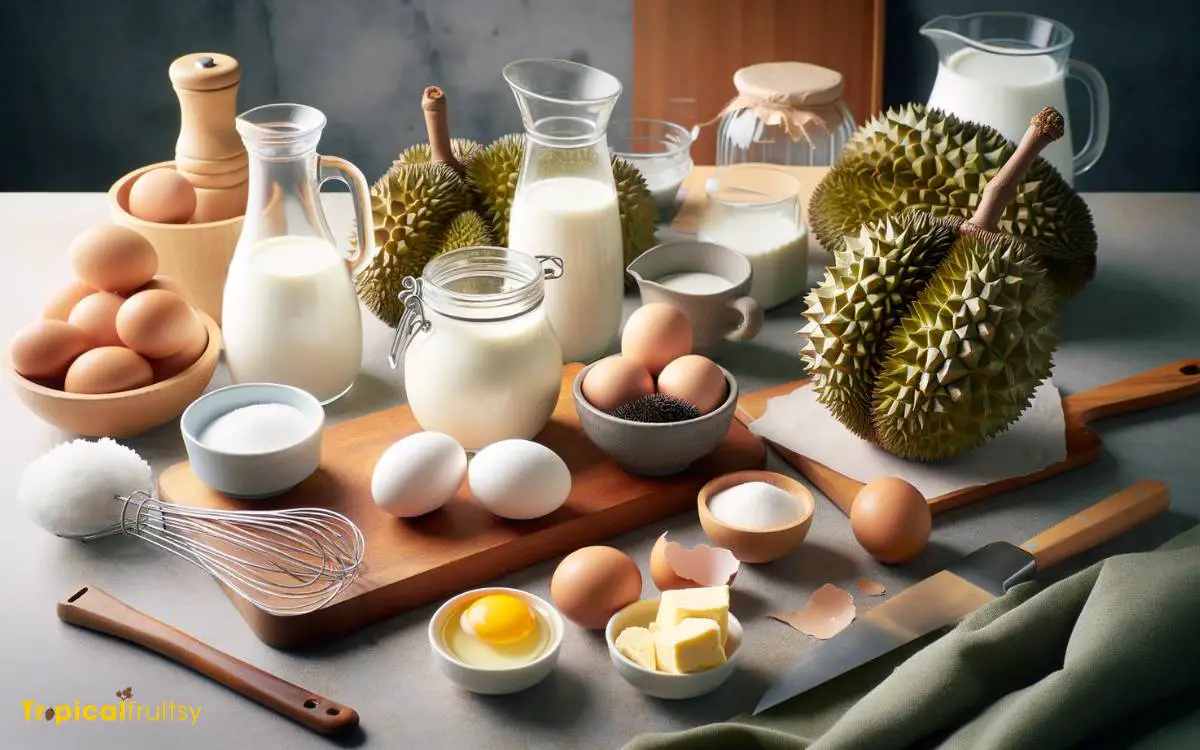
Following the selection of a ripe durian, one must proceed to gather and prepare the remaining ingredients necessary for crafting a delectable durian custard.
Begin by sourcing fresh, whole milk – the foundation of your custard’s creamy consistency. Measure with precision to ensure balance in texture and flavor.
Procure fine granulated sugar to sweeten, and select farm-fresh eggs, their yolks a rich hue, promising a silken firmness upon gentle coagulation.
A pinch of sea salt will heighten the flavors, and pure vanilla extract will add a subtle aromatic warmth.
Cornstarch, as a thickening agent, must be sifted to avoid lumps, guaranteeing a smooth, velvety custard.
Each ingredient requires meticulous attention, as they are integral to the alchemy that transforms simple components into a luxurious, fragrant dessert.
Step 3: Blending the Durian Flesh
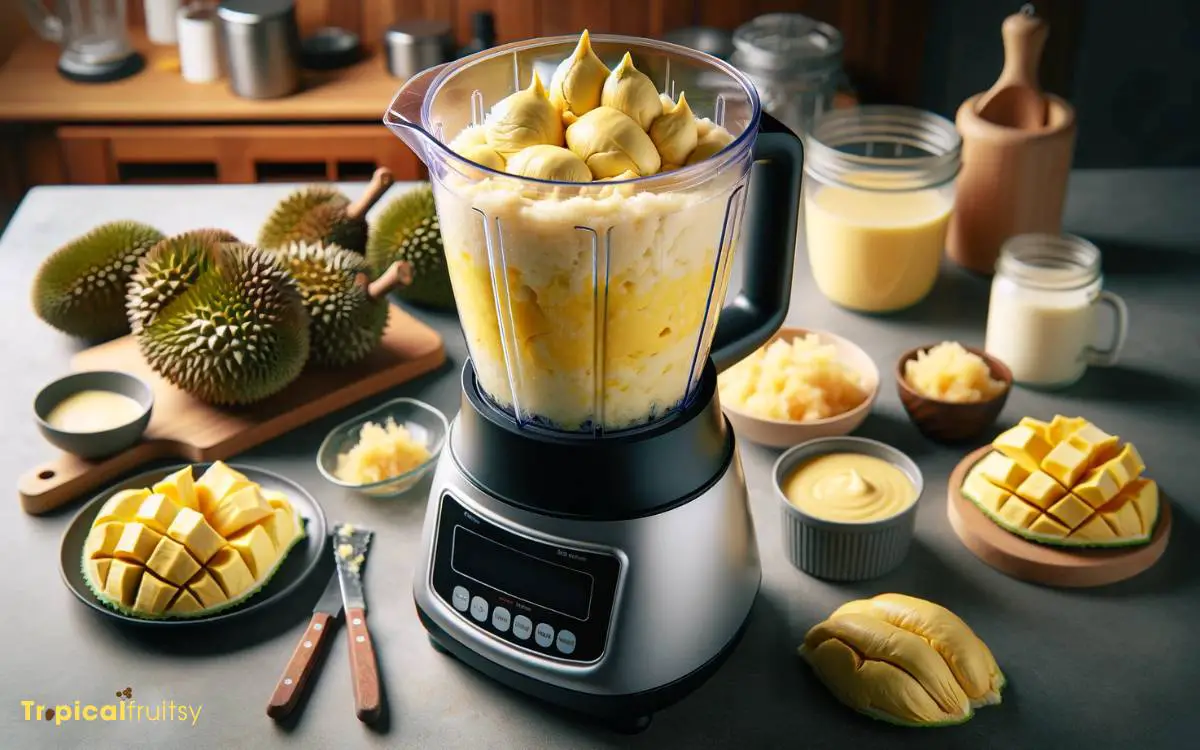
The transformation of durian flesh into a silken custard begins with the meticulous selection of fruit at the pinnacle of ripeness, ensuring a balance of sweetness and complexity.
Once the creamy lobes are extracted, they are subjected to a high-speed blending process, designed to rupture the cells and release the full spectrum of flavors while achieving a homogeneous puree.
To attain a velvety texture, this aromatic blend is then passed through a fine-mesh sieve, removing any fibrous remnants and establishing a uniform base for the custard.
Choosing Ripe Durian
Before delving into the custard-making process, it is essential to select a ripe durian, as the fruit’s maturity significantly influences the texture and flavor of the custard.
The flesh of a ripe durian should yield gently to pressure, emanating a rich, bittersweet aroma — a siren song for the taste buds.
Its pods, plump with creamy pulp, should detach easily from the rind, indicating the peak of ripeness ideal for blending into a silken custard.
- Aroma Test: A ripe durian emits a distinctive, potent smell that is pleasantly sweet and not overly fermented.
- Stem Check: Look for a dry, withered stem; it often means the durian has naturally ripened and fallen from the tree.
- Give it a Shake: A subtle rattling sound suggests the seeds have some room to move, a sign the flesh is soft and creamy, perfect for custard.
Smooth Puree Techniques
To create a velvety durian puree, one must meticulously blend the fruit’s flesh until it reaches a uniformly smooth consistency. This process is both an art and a science, requiring precision and a delicate touch.
Begin by removing the seeds and any tough fibrous parts, ensuring that only the creamiest segments of the durian are poised for pureeing.
Employ a high-powered blender or food processor, pulsing initially to break down the larger pieces, then transitioning into a steady puree.
Monitor the texture closely; it should whisper softness and ooze silkiness. If necessary, employ a fine-mesh sieve to strain the mixture, eradicating any lingering fibrous particles.
This will yield a luscious base, the quintessence of durian’s distinctive flavor, ready to be transformed into a sumptuous custard.
Straining for Consistency
After blending the durian flesh into a smooth puree, it is imperative to strain the mixture through a fine-mesh sieve to ensure a consistent, lump-free custard base.
This process not only refines the texture but also enhances the silken quality of the final custard. Painstaking attention to this step rewards the palate with an exquisite mouthfeel that is both luxurious and delicate.
- Silken Perfection: Straining removes any fibrous remnants, achieving a velvety texture that is quintessential to custard.
- Flavor Intensification: Unwanted particulates are discarded, concentrating the durian’s complex taste profile.
- Visual Appeal: A smooth strain ensures an aesthetically pleasing custard, free from imperfections that could mar its opulent appearance.
Step 4: Cooking the Custard Base
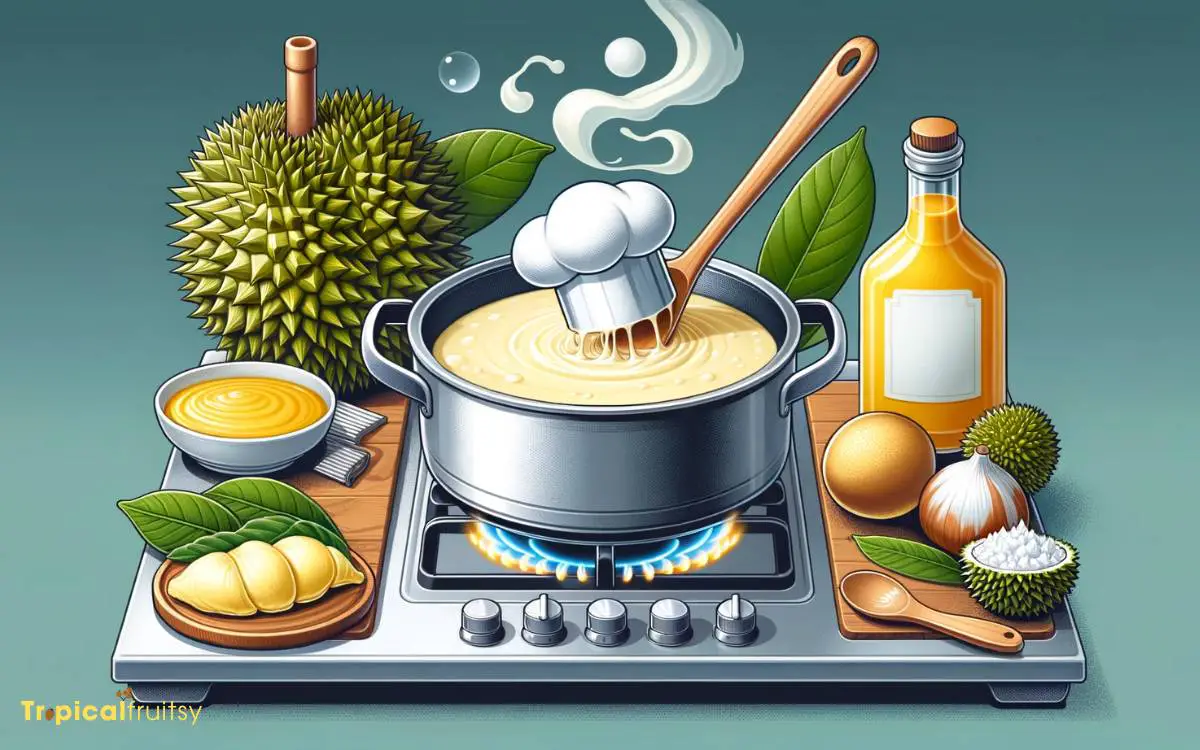
Begin the custard base by whisking together three large eggs and 100 grams of granulated sugar in a medium heatproof bowl until the mixture is homogenous and pale in color.
As you conduct this alchemy of simple ingredients, the sugar crystals dissolve into the silken fabric of the eggs, creating a lustrous emulsion that will serve as the cornerstone of your custard.
Methodically, temper this blend with 250 milliliters of warm milk, infused with the tropical essence of durian, stirring continuously to prevent scrambling.
The mixture should then be transferred to a saucepan and cooked over a gentle flame. With the precision of an artisan, stir constantly with a wooden spoon, until the custard thickens enough to coat the back of the spoon.
Step 5: Combining and Refining
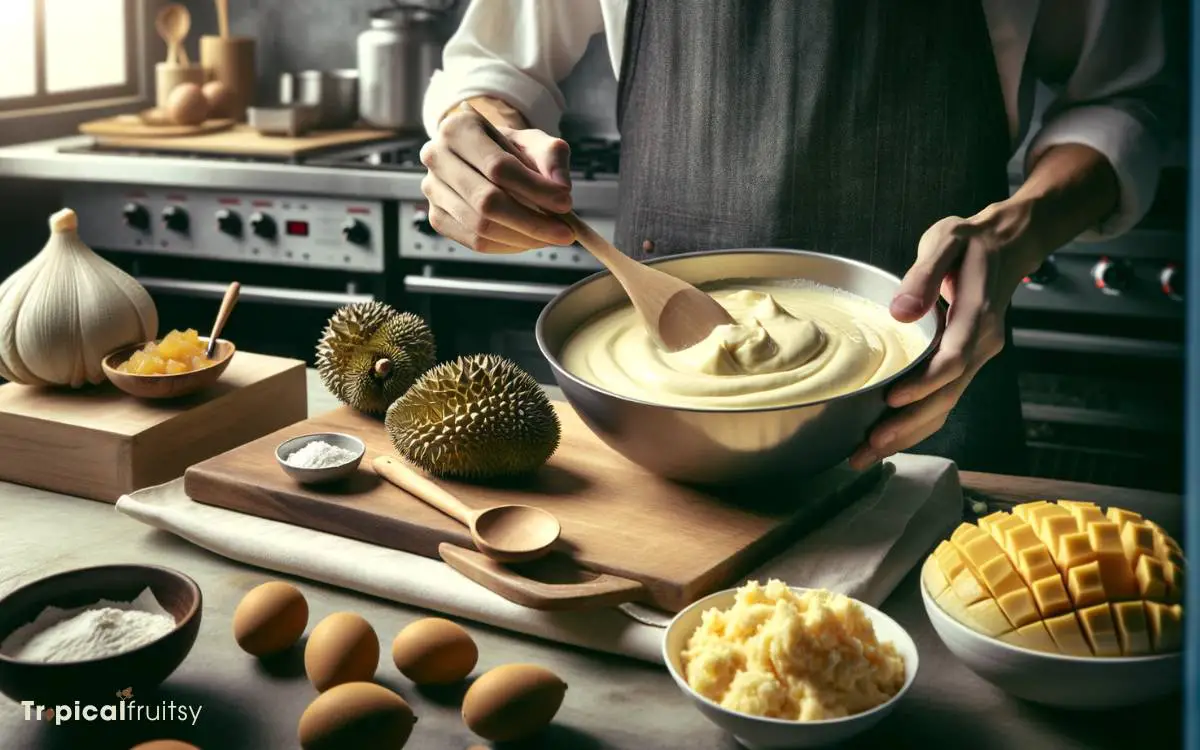
As we transition into the delicate phase of combining and refining our durian custard, it is paramount to maintain a silken texture. This will be achieved by meticulously folding the durian puree into the custard base.
Expertise in flavor blending is essential in this process. The pungent essence of durian must harmonize with the creamy sweetness of the custard without overwhelming the senses.
Precise heat control is the linchpin in this process. It ensures that the custard cooks to a perfect consistency without curdling or separating.
Texture Considerations
When combining durian pulp with the custard base, it is essential to achieve a smooth and homogenous texture that is neither too runny nor excessively thick.
The voluptuousness of the custard should complement the durian’s creamy opulence, inviting the palate to a luxurious experience.
Care should be taken to ensure that the stirring technique doesn’t incorporate too much air, which could lead to an undesirably frothy consistency, diminishing the custard’s rich indulgence.
- Sieve the durian puree through a fine mesh to remove any fibers, ensuring a refined silkiness in every spoonful.
- Monitor the cooking temperature closely, as excessive heat can curdle the eggs, resulting in a granular mouthfeel.
- Employ a folding method when combining ingredients to retain a velvety texture, safeguarding against overmixing which can deflate the custard’s delicate body.
Flavor Blending Techniques
Having achieved the desired texture, the next step in crafting durian custard is to masterfully blend the flavors, ensuring that the essence of durian is prominent yet balanced within the creamy concoction.
Flavor blending is both an art and a science, requiring a delicate touch and a discerning palate.
The interplay of durian’s complex notes with the velvety base demands a symphonic approach, where each ingredient contributes to the final gustatory harmony.
| Ingredient | Role in Flavor Blending | Notes |
|---|---|---|
| Durian | Base Note | Robust, with a sweet intensity |
| Cream | Supporting Note | Adds richness and smooths edges |
| Vanilla | Accent Note | Elevates with a subtle bouquet |
Heat Control Methods
Precise temperature management is essential for the successful integration of flavors in durian custard, ensuring that the custard sets to the perfect consistency without compromising the integrity of the delicate durian essence.
The act of combining and refining through heat control is akin to a maestro composing a symphony, where each note must harmonize with the next to create a flawless performance.
- Gentle Simmering: Infuses the durian flavor subtly, avoiding the harshness that high heat can impart.
- Double Boiler Technique: Implements indirect heat to coalesce ingredients smoothly, preserving their nuanced profiles.
- Thermometer Utilization: Ensures precision by monitoring the temperature, crucial for achieving the custard’s silken texture.
Employing these techniques with an artisanal touch will elevate the durian custard from a mere dessert to a culinary masterpiece.
Step 6: Serving and Storage Tips
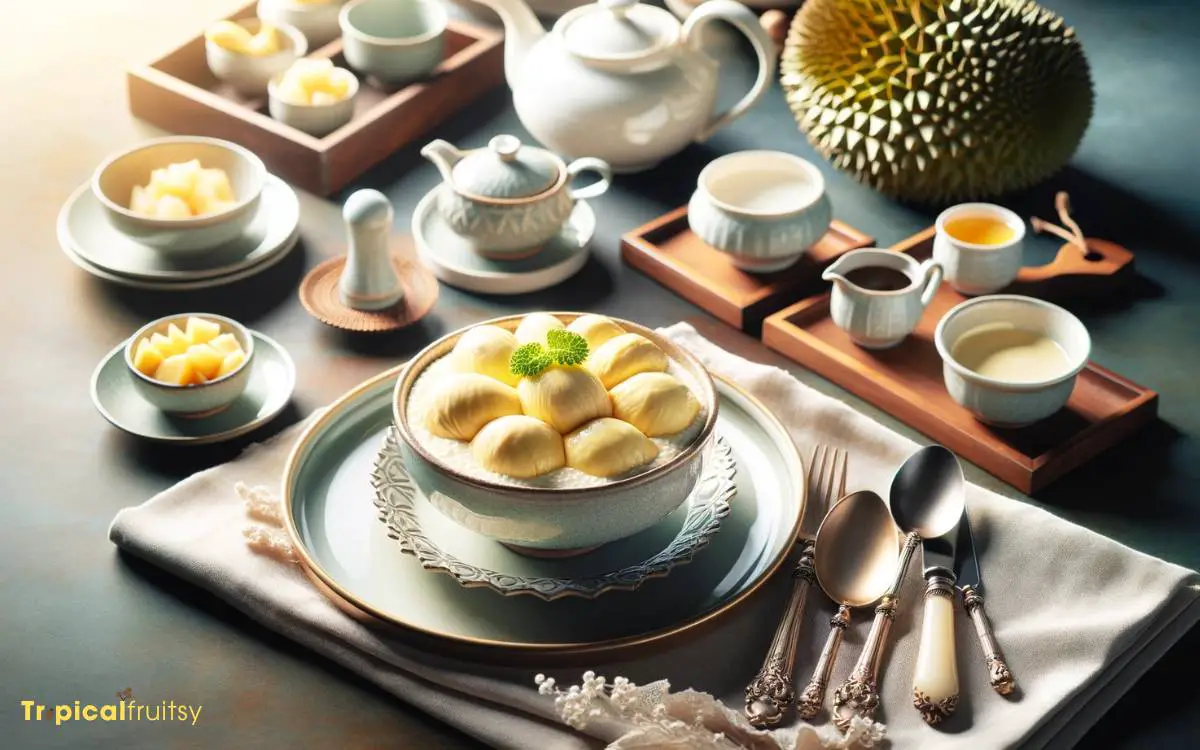
Serving durian custard chilled enhances its creamy texture and mitigates the potent aroma, making it more palatable for those unaccustomed to the fruit’s distinctive smell.
To achieve the ideal consistency, refrigerate the custard for at least two hours prior to serving, allowing the molecular structure to amalgamate into a silken symphony of flavors.
An elegant garnish of mint or a delicate sprinkle of powdered sugar can complement the custard’s rich profile.
For storage, transfer the custard into an airtight container to prevent absorption of other odors from the refrigerator. Durian custard can be stored for up to three days, though its textural integrity is best within the first 24 hours.
Always serve at a modest chill to maintain the exquisite balance of taste and fragrance.
Conclusion
The creation of durian custard juxtaposes the complexity of its preparation with the simplicity of its enjoyment.
Though the fruit’s aroma may deter the uninitiated, the alchemy of heat and whisking transforms it into a silken indulgence.
This culinary paradox embodies the irony that the most divisive of fruits can yield a dessert of universal appeal.
Properly stored, the custard stands as a testament to the artful marriage of technique and exotic flavor.


